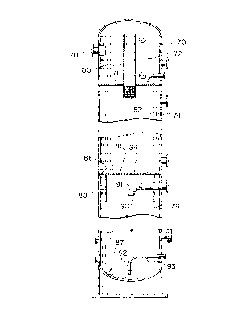Some of the information on this Web page has been provided by external sources. The Government of Canada is not responsible for the accuracy, reliability or currency of the information supplied by external sources. Users wishing to rely upon this information should consult directly with the source of the information. Content provided by external sources is not subject to official languages, privacy and accessibility requirements.
Any discrepancies in the text and image of the Claims and Abstract are due to differing posting times. Text of the Claims and Abstract are posted:
| (12) Patent Application: | (11) CA 2270152 |
|---|---|
| (54) English Title: | APPARATUS AND METHOD FOR REMOVING ENTRAINED LIQUID FROM GAS OR AIR |
| (54) French Title: | DISPOSITIF ET PROCEDE SERVANT A SUPPRIMER DU LIQUIDE ENTRAINE DEPUIS DU GAZ OU DE L'AIR |
| Status: | Deemed Abandoned and Beyond the Period of Reinstatement - Pending Response to Notice of Disregarded Communication |
| (51) International Patent Classification (IPC): |
|
|---|---|
| (72) Inventors : |
|
| (73) Owners : |
|
| (71) Applicants : |
|
| (74) Agent: | NEXUS LAW GROUP LLP |
| (74) Associate agent: | |
| (45) Issued: | |
| (86) PCT Filing Date: | 1997-02-14 |
| (87) Open to Public Inspection: | 1998-08-20 |
| Examination requested: | 1999-04-27 |
| Availability of licence: | N/A |
| Dedicated to the Public: | N/A |
| (25) Language of filing: | English |
| Patent Cooperation Treaty (PCT): | Yes |
|---|---|
| (86) PCT Filing Number: | 2270152/ |
| (87) International Publication Number: | CA1997000107 |
| (85) National Entry: | 1999-04-27 |
| (30) Application Priority Data: | None |
|---|
Apparatus for removing liquid entrained or dissolved in gas from the gas which
includes a distributor (82) located proximate an inlet region of a bed (74)
containing a network of channels bounded by solid material having sharp
protuberances, so as to cause the liquid entrained in the gas to condense, for
directing the gas through said bed (74). A collector (87), located proximate
an outlet region of said bed (74), is operative to collect the liquid that has
condensed in the bed (74) and to direct the gas which emerges from the bed
(74) away from the bed.
Dispositif servant à supprimer du liquide entraîné ou dissous dans du gaz depuis ce gaz et comprenant un distributeur (82) situé à proximité d'une zone d'entrée d'un lit (74) contenant un réseau de canaux limités par un matériau solide présentant des protubérances aiguës, de manière à provoquer la condensation du liquide entraîné dans le gaz, servant à diriger le gaz à travers ledit lit (74). Un collecteur (87) situé à proximité d'une zone de sortie dudit lit (74) sert à recueillir le liquide s'étant condensé dans le dit (74) et à diriger le gaz émergeant du lit (74) afin qu'il s'éloigne de ce dernier.
Note: Claims are shown in the official language in which they were submitted.
Note: Descriptions are shown in the official language in which they were submitted.

2024-08-01:As part of the Next Generation Patents (NGP) transition, the Canadian Patents Database (CPD) now contains a more detailed Event History, which replicates the Event Log of our new back-office solution.
Please note that "Inactive:" events refers to events no longer in use in our new back-office solution.
For a clearer understanding of the status of the application/patent presented on this page, the site Disclaimer , as well as the definitions for Patent , Event History , Maintenance Fee and Payment History should be consulted.
| Description | Date |
|---|---|
| Inactive: Agents merged | 2011-07-06 |
| Application Not Reinstated by Deadline | 2001-02-14 |
| Time Limit for Reversal Expired | 2001-02-14 |
| Deemed Abandoned - Failure to Respond to Maintenance Fee Notice | 2000-02-14 |
| Inactive: Office letter | 2000-01-19 |
| Inactive: Office letter | 2000-01-19 |
| Inactive: Protest/prior art received | 1999-09-15 |
| Inactive: Cover page published | 1999-07-13 |
| Inactive: IPC assigned | 1999-06-15 |
| Inactive: First IPC assigned | 1999-06-15 |
| Inactive: IPC assigned | 1999-06-15 |
| Inactive: Acknowledgment of national entry - RFE | 1999-05-31 |
| Letter Sent | 1999-05-31 |
| Letter Sent | 1999-05-31 |
| Application Received - PCT | 1999-05-28 |
| Request for Examination Requirements Determined Compliant | 1999-04-27 |
| All Requirements for Examination Determined Compliant | 1999-04-27 |
| Application Published (Open to Public Inspection) | 1998-08-20 |
| Abandonment Date | Reason | Reinstatement Date |
|---|---|---|
| 2000-02-14 |
The last payment was received on 1999-04-27
Note : If the full payment has not been received on or before the date indicated, a further fee may be required which may be one of the following
Patent fees are adjusted on the 1st of January every year. The amounts above are the current amounts if received by December 31 of the current year.
Please refer to the CIPO
Patent Fees
web page to see all current fee amounts.
| Fee Type | Anniversary Year | Due Date | Paid Date |
|---|---|---|---|
| MF (application, 2nd anniv.) - small | 02 | 1999-02-15 | 1999-04-27 |
| Registration of a document | 1999-04-27 | ||
| Basic national fee - small | 1999-04-27 | ||
| Request for examination - small | 1999-04-27 |
Note: Records showing the ownership history in alphabetical order.
| Current Owners on Record |
|---|
| HYDRO PACIFIC TECHNOLOGIES INC. |
| Past Owners on Record |
|---|
| IAN S. PARKER |
| ROBERT J. MCKENZIE |